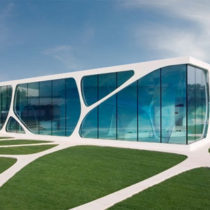Landscape Architecture for Landscape Architects › Forums › PLANTS & HORTICULTURE › The End of Groundcovers?
- This topic has 1 reply, 11 voices, and was last updated 13 years, 10 months ago by
 Vance W. Hall.
Vance W. Hall.
-
AuthorPosts
-
June 14, 2010 at 11:01 am #169111
 Thomas RainerParticipant
Thomas RainerParticipantIf I could banish one word from the English language, it would be “groundcover.” The era of the groundcover must end. While this age of American landscape design has its roots in the Victorian garden, it has been the dominant landscape ethos since the post WWII housing boom. The primary idea of this era is that non-lawn planting beds need to be covered in a low maintenance, evergreen groundcovers such as English ivy, periwinkle, or pachysandra. The results of this philosophy on our landscapes are nothing short of catastrophic: millions of acres of meadow and forest have been decimated by these invasives, and we’ve forsaken the spiritually enriching act of gardening for the environmentally impoverishing act of landscaping.
Read more at http://www.groundeddesign.com
June 14, 2010 at 4:46 pm #169127 Vance W. HallParticipant
Vance W. HallParticipantI am lucky enough to live in the foothills of the Rockies. Here we are able to use a number of perennials, grasses and annuals to infill our beds and tree lines. We have a climate that will sustain a beautiful pallet of non-invasive hearty plants. This allows the average person to easily maintain and implement an environmentally friendly garden. However, this is not the case in many areas of the country.
You are talking about developing complex micro climates. Once they are settled they typically do great, but are often more expensive and time consuming to start. It is a hard sell to the client. Also, other than your advanced gardener or Landscape Architect few people even grasp your concept. I love the idea of a more conscious effort, but it will start with education of the end user and our up and coming LA’s.
Thomas thanks for the food for thought this Monday.
June 14, 2010 at 4:50 pm #169126 Vance W. HallParticipant
Vance W. HallParticipantI really enjoy your site. If anyone has not seen it check it out. http://www.groundeddesign.com
June 14, 2010 at 6:59 pm #169125 Jason T. RadiceParticipant
Jason T. RadiceParticipantIts not just ground covers, but invasives in general. There are plenty of ground covers that can be used unrestrained, and some that must be restrained. I’m still seeing state-labeled invasives on LAs planting lists, however. Should be a required ECU.
June 14, 2010 at 7:50 pm #169124 Thomas RainerParticipant
Thomas RainerParticipantI wanted to focus on groundcovers in particular, not just invasives, because they represent a design concept that I think is dated and needs to change. As designers, we don’t need to be covering the ground anymore, we need to be expressing the ground plane in dynamic ways. Groundcovers represent a mentality within planting design that I think must change.
June 14, 2010 at 8:08 pm #169123Nate Hommel
ParticipantI really enjoyed your latest post. I agree with the others that it is as much about diversity as it is about eradicating groundcovers from the LA plant pallet. I have found that in recent years many institutional and developer clients are more and more willing to see more perennials and meadows rather than huge expanses of lawn and groundcover.
June 14, 2010 at 8:36 pm #169122 Trace OneParticipant
Trace OneParticipantI agree, I like Grounded Design – very nice site! Here in Fresno, we just pattern the bare dirt with regular rake marks, it ends up looking sort of like the symbol for earth, really cracked me up when I moved here..They rake the dirt..hee hee..
June 15, 2010 at 1:34 am #169121 Zach WatsonParticipant
Zach WatsonParticipantMaybe I’m the only one here, but I personally enjoy the groundcovers. While they are not the solution for ever situation to rule them out completely is disregarding an entire branch of the design tree.
June 15, 2010 at 2:04 am #169120 Andrew Garulay, RLAParticipant
Andrew Garulay, RLAParticipantI agree with Zach. While often over used, groundcovers have a practical application in many situations as well as having aesthetic uses. Why not decide that shrubs are outdated since they are so widely used. To be against ALL groundcover use sounds like imposing a personal bias rather than a practical reason.
Many are invasive, but not all. Huge monocultures can be susceptible to disease or pests, but many small areas of monocutures are found in natural understories and seldom do I see huge areas of monoculture ground covers. One common native groundcover in my area that naturally occurs in large monocultures is Arctostaphlos uvi-ursi (bearberry) and it looks awesome, especially on a sand dune.
So we don’t want lawns and we don’t want groundcovers. That leaves trees, shrubs, tall meadows, built structure, mulch, or pavement. I think we need to have to have something living on that ground plane sometimes, don’t you?
I can’t imagine going through life without stepping on something green every now and again. I suppose there will always be New York Jets memorabelia, but I’m taliking about in the landscape.
June 15, 2010 at 3:24 am #169119 Cliff SeeParticipant
Cliff SeeParticipanthmmm, i enjoy good ground cover too… almost anything can be considered invasive, rarely is there a balance, somethings win, somethings lose, it is a matter of the quality of care.
Nature has its own way (ie your meadow and forest)… but we landscape architects don’t re-create nature… we ultimately design for humans, with nature in mind, however we are all the things that nature isn’t, while in fact, nature is all things we are not. both sides of the same coin.
why a sculpture can be as beautiful as a tree, or my living room as serene as a meadow, I’ll never know…June 15, 2010 at 5:29 am #169118 Jason T. RadiceParticipant
Jason T. RadiceParticipantDitto. The natural order of things has ground covers. While I do agree with your argument for careful species selections, groundcovers provide a much needed aesthetic and natural function in the designed landscape. For the commercial work that I do, groundcovers are a must. Mostly for erosion control and aesthetic values (maintain site lines), as well as keeping lawn areas to a minimum. They vastly reduce maintenance costs and air quality issues from maintenance equipment, as well as mitigates the whole mulch issue. The nature of the industry and the tastes of clients often restricts the aesthetics proposed, and to what is practical for certain developments. A meadow is not appropriate in most uses. We need groundcovers.
June 15, 2010 at 9:01 am #169117al fathi
Participanttom et al., u have a valid argument especially on the invasive characters of groundcovers in general. but so do others. and as jason pointed out there are those that can be used unrestrained. and personally im sure that groundcovers have their own merits when we take a closer look. to me, some groundcovers are actually good when it comes to retaining slopes and for the purpose changing the microclimate of a given place sans the mowing of turf as in alternative approach.
at the same time however i prefer ‘naked’ ground with just turf or bushes and trees. i embrace this concept for more than 10 yeras already. the advantage of this is reduction in maintenance cost and resources such as water. many developments in water challenged countries nowadays promote water saving as in the UAE thru their ‘estidama’ approach and even newer developments in tropical thailand and malaysia. when planning for saving water for the soft landscape design, groundcovers are the first to go. last, i believe we should start looking differently at how to use groundcovers to the best advantage given the locale that we have.
June 15, 2010 at 11:30 am #169116 Andrew Garulay, RLAParticipant
Andrew Garulay, RLAParticipantI think there is always a tendency for any of us to project the problems in the regions we work in to all others. A problem in one place is a solution in another. This is most commonly applied by people in low rainfall areas deciding that everywhere else needs to act like there is no water for some reason.
What is invasive in one region is not necessarily invasive in another. Actually, what is ubiquitous in landscapes of one region may be non-existent in others. Seldom to we see groundcovers in commercial landscapes in my area. Thirty years ago we’d see a lot of pachysandra or vinca. Hedera has been avoided for a lot longer than that.
June 15, 2010 at 3:13 pm #169115 Jonathan StaldineParticipant
Jonathan StaldineParticipantI pretty strongly agree with Andrew, it’s actually a fact that really bothers me sometimes… even in the academic world. I recently had a project involving a stream reclamation near Boise. The so-called creek is heavily channelized, with banks largely in excess of 1:1 slopes, in gravelly, sandy soil prone to high salinity. Nasty. Our objective stated a naturally inspired reclamation, but most of my classmates dropped the natural concept at regrading the stream and introducing sinuosity back to it’s character. A ‘riparian corridor’ of between 150 to 300 feet wide was more or less the status quo and most did not follow native plantings at all – instead we were encouraged by the instructor to remove massive amounts of topsoil and replace it with soil brought in. All this in an area that receives around 9 inches annually, largely in the fall and winter months.
I feel that often times a meadow is a wonderful concept, but it fails in practice, and it is hardly suitable to shady sites. If that became the next big thing, how will the future prove it to be any different than ground covers? If anything, it can introduce a host of new problems, new vectors, and definitely new concerns. I’m from NE Wyoming, short grass prairie land, and believe me it is rather flammable, particularly when you add in ecological plantings like sagebrush.
Many times a whole plant becomes pariah labeled as highly invasive or noxious when in fact, only the species or particular cultivars are really of concern. Creeping Jenny is a notorious groundcover, but the cultivar ‘Aurea’ is much, much more behaved. Properly bounded, and routine maintenance instructed and enforced there is no reason why we should all cast away groundcovers.
On a whole level, I believe that we should develop a greater understanding of the nature and character of our own surroundings. I’ve noticed that a lot of what happens in this field seems to be driven by fads and trends. Pick up any monthly issue of Landscape Architecture and I can almost guarantee that somewhere within it’s covers green roof structures are exalted, meadows are praised, and bioswales are end-all-be-all answer to the sins of modern man. Properly sited, any one of those things can be a great asset. But they are not a holistic answer to every question, nor is banishing all groundcovers, or striking Groundcover from the English language.
Sorry Thomas, but blanketed “answers” have never really served the world well.
June 15, 2010 at 3:17 pm #169114Mike G
ParticipantInteresting article and great site Thomas.
However I think we owe groundcovers credit for setting the tone for contemporary and ‘naturalistic’ aesthetics. In many situations gcs act as a gateway drug for the horticultural community and those weary of an untamed nature, as some see in a restored prairie or meadow. As a gateway drug, it starts with getting rid of a little turf, adding a few perennials, and then moving onto larger sections of property. Gcs are, and will continue to be, a great leaping point for planting alternatives that consume turf. -
AuthorPosts
- You must be logged in to reply to this topic.

